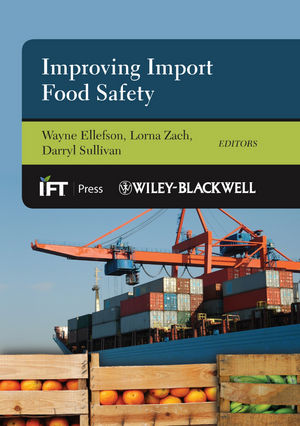Building a World-class Allergen Control Program, Part 2

Part 1 of this article discussed the following elements of allergen control: research and development, vendor approval and selection (purchasing), shipping and receiving, warehousing and human resources. In this article we will cover production, labeling and sanitation.
Production and Production Scheduling
Allergen control in production operations is a combination of production scheduling, programs designed to minimize cross-contamination, good sanitary design of equipment and facilities, proper control and labeling of raw materials and ingredients, good sanitation practices and the application of technologies, especially vision systems, to “catch” containers or packages that are going where they should not be going. As was emphasized previously, there must be documented procedures that include proper monitoring and corrective actions.
Production scheduling: Food processors who are processing and handling allergens need to establish rigid protocols for production scheduling to minimize the potential for allergen cross-contamination. Processors packaging organic products will run those items first thing in the morning on clean lines, so the organic items are not “contaminated” by conventional products. Allergens should be scheduled at the end of the work day for the same reasons. If there are products that have slightly different formulations, say one contains egg noodles (wheat and egg) and the other contains a whole-wheat pasta, the item containing the two allergens should be scheduled later in the day. Depending upon the products being run, different cleaning procedures should be developed for use between products. These protocols will be addressed in the sanitation section below.
Another means to minimize allergen contamination is to establish dedicated lines for manufacturing products containing allergens. Ideally, such a line would be separated physically from lines used to manufacture products without allergens.
In many plants, those responsible for production scheduling will not only develop the schedules, but provide production with paperwork that includes formulations, batching and coding information and any other pertinent information germane to manufacturing. These documents should also highlight any allergens that are used in the products. Some companies even place colored stickers on the paperwork that highlight the allergen or allergens being handled.
Sanitary design: Sanitary design of equipment and facilities, including giving proper consideration to traffic patterns and ventilation, is a key element not only for allergen control, but to prevent contamination of any kind. Plant design should include dedicated areas for staging and mixing allergens and the use of dedicated lines for processing allergens. One of the largest concerns in food-processing facilities is potential contamination though dusting. Areas where dry ingredients such as wheat flour, soy protein or cheese powders are dumped and mixed must be designed with proper ventilation to ensure that these allergens do not spread through the plant. Often, plants install blowers that blow dust into the plant. Dry ingredient-handling plants must pay attention to ensuring that connections between lines and pipes are properly gasketed to minimize leakage. Sanitary design is another topic to which one could devote an entire piece.
Staging and ingredient usage: When gearing up for a production run, it is important to consider how ingredients are organized and staged in order to minimize potential allergen cross-contact. Persons working in this area must make sure that ingredients containing allergens are properly labeled. This will serve as a check on receiving and warehouse operations and will ensure that production personnel understand that they are working with allergens. One key activity is to ensure that partial bags of ingredients have been labeled as to the date they were opened and properly sealed so that there are no leaks or spills. As part of this program, tops of drums and pails should be cleaned for use in blending operations.
 Dedicated utensils: Another means for minimizing cross-contamination with allergens is through the use of dedicated utensils, containers and tools. One way to accomplish this is to establish a program whereby each allergen is handled using only certain colored tools. For example, ingredients containing milk might be handled with white scoops and those with soy, yellow. Plastic utensils and other tools are available in a wide range of colors as seen in Figure 1. When using plastic tools, workers should be trained to remove any implement that is damaged to minimize the potential for contamination.
Dedicated utensils: Another means for minimizing cross-contamination with allergens is through the use of dedicated utensils, containers and tools. One way to accomplish this is to establish a program whereby each allergen is handled using only certain colored tools. For example, ingredients containing milk might be handled with white scoops and those with soy, yellow. Plastic utensils and other tools are available in a wide range of colors as seen in Figure 1. When using plastic tools, workers should be trained to remove any implement that is damaged to minimize the potential for contamination.
Some operations worry about using plastic, fearing that it may crack or flake, so another option is to utilize dedicated stainless steel implements. When this is done, it is imperative that these tools be clearly labeled and stored so that they do not get used where they should not be. To minimize such concerns, some operators store utensils such as scoops or spoons with the ingredient. This is much easier if ingredients are transferred to plastic or metal bins or totes for storage. The utensils may be attached to the bin or stored in the container itself. Manufacturers of stainless steel utensils could even consider producing these items with colored bands or handles.
Proper labeling of work-in-progress (WIP): In many cases, processors will pre-batch certain materials for use in a finished blend. These could be meats destined to be filled into an appetizer, or a spice blend. These batched items, known as work-in-progress or WIP, must be properly labeled for both traceability and allergen control. As noted in the discussion of production scheduling, the use of tags that highlight the allergen in the batch can help minimize the potential for allergen contamination.
Rework: In the food industry, rework is becoming a “four-letter word.” Rework occurs when a processor takes product from a batch or lot and adds it to another item manufactured at a later date. For example, if a lot of product that is manufactured on August 7 is found to be defective in some way, the processor may elect to add the item in question back into the same or a similar product later on. Doing this poses traceability issues and, if the product contains allergens, potential problems with the allergens in question. If your company does rework product, make sure that the product to be reworked is properly labeled, that a plan for rework is established and followed, and that the reworked products are properly documented to ensure traceability. Replacing damaged labels or recasing products that were damaged is not rework; instead, use a term such as recouping or recasing. Rework has a very bad connotation. Of course, even when doing something as simple as recasing or re- labeling products, care must be taken to do the work correctly and document that it was done.
Line sweeps: Every time a processor does a product change, it is essential that the line be prepared for the next item to be run. This involves cleaning up to and including the filler. The kind of cleaning that will be done will depend on the product that was run and what is to be run next. Good production scheduling should help make these changeovers easier and more efficient. From the fillers or packing machines, quality and/or production personnel should sweep the line all the way through to casing and palletizing. This sweep is aimed at ensuring that there is no product or labeling material from the previous run on or around the lines. Personnel assigned to this task should walk the line and remove any containers, labels or items remaining from the run just completed. This should include ensuring that trash bins or waste receptacles are emptied and that quality samples are moved into the testing facilities. No materials from the previous run should be on or near the line. Records that this work was done must be maintained.
Labeling
 The importance of labeling allergens comes up again and again. Ideally, foods and ingredients containing allergens should be labeled by vendors. Persons in receiving should be supplied with updated lists of allergen-containing materials so those items can be tagged upon arrival (see sample label tags in Figure 2). The warehouse staff must store allergens in designated and marked areas and stage materials for production to minimize potential problems. Production records and scheduling documents should flag allergens. Finally, it is imperative that companies establish programs to ensure that the right labels are applied to all containers to be sure that consumers are properly informed. If foods containing allergens—but not labeled as such—are inadvertently released into distribution, a recall will be necessary. It is the label, as noted in part 1, that lets sensitive consumers make the right choices to protect themselves. The FDA requires that food labels note potential allergens; an example is shown in Figure 3 (also at www.cfsan.fda.gov/ ~dms/2lg-6.html#label).
The importance of labeling allergens comes up again and again. Ideally, foods and ingredients containing allergens should be labeled by vendors. Persons in receiving should be supplied with updated lists of allergen-containing materials so those items can be tagged upon arrival (see sample label tags in Figure 2). The warehouse staff must store allergens in designated and marked areas and stage materials for production to minimize potential problems. Production records and scheduling documents should flag allergens. Finally, it is imperative that companies establish programs to ensure that the right labels are applied to all containers to be sure that consumers are properly informed. If foods containing allergens—but not labeled as such—are inadvertently released into distribution, a recall will be necessary. It is the label, as noted in part 1, that lets sensitive consumers make the right choices to protect themselves. The FDA requires that food labels note potential allergens; an example is shown in Figure 3 (also at www.cfsan.fda.gov/ ~dms/2lg-6.html#label).

Scanning technology: Processors that are truly concerned about allergens should take a long look at the different kinds of scanning technologies available on the market today. These technologies have evolved very quickly in the past few years and provide processors with a tool or series of tools to help ensure that products are not only properly labeled but that the product matches up with the label. These technologies can be set up to scan ink codes or labels as they are being put on containers, or they can be designed as integrated systems.
A processor can do everything correctly during the initial phases of processing and still end up with the wrong label on a container. Suppliers occasionally co-mingle labels from different products. Processors may also inadvertently mix labels. Manufacturers of low-acid foods who brite stack products or hold finished products in gondolas or crates may also inadvertently co-mingle one kind of product with another.
The Campbell Soup Company is one processor that has adopted this technology to its benefit. According to Steve DeMuri from Campbell’s Sacramento, CA facility, the company began looking at scanning technology in 2001. The company had selected particular firms for can code-recognition systems to detect and read printed can codes and to supply equipment to scan and read label bar codes. Selection criteria included not only the ability of the vision systems manufactured by the vendors to adequately scan product on-line quickly and efficiently but also the commitment of the supplier to work with Campbell’s on continuously improving the systems. The Campbell Soup Company has installed can code-recognition systems on all thermally processed labeling lines, in addition to the bar code readers on all labelers in their North American facilities, and are now investigating the support and installation of these systems throughout the world. An integration and control system was cooperatively developed with a third supplier to integrate reads of container codes and scans of bar codes on labels. If the container code does not match that on the label, the line shuts down immediately and cannot be started again until an investigation of the deviation has been conducted. According to Ann Gasiorek of Campbell’s Worldwide Quality, the adoption of this scanning technology has been “hugely successful.” These systems have also helped to discover gaps in their quality systems and reduced alleged labeling-
related complaints by 97% without negatively affecting operational efficiencies.
Cleaning and Sanitation
No matter what product a company is manufacturing, cleaning and sanitation are essential to allergen control. Cleaning is obviously much easier when manufacturing wet products. Cleaning and allergen control with dry products pose greater problems. Processors should work closely with their chemical suppliers to determine the best chemicals and procedures for cleaning their plants. As noted earlier, processors must be sure that lines are properly cleaned whenever an allergen-containing product is processed. Many processors utilize different cleaning regimens, one for non-allergens and another for allergens. When developing a cleaning protocol for allergens, that procedure must be validated to ensure that it adequately removes the allergen.
Once the procedure has been established, it must be documented, and those persons assigned to do the work must be trained on that procedure. The cleaning program should also include a protocol to verify that the equipment being cleaned is being cleaned properly. Verification may include the use of chemical tests, microbiological swabs, adenosine triphosphate (ATP) swabs or one of the allergen swabs. If the latter is selected, be sure to validate that the specific test works in your plant. Never assume—validate.
Cleaning to control allergens applies to the whole system. Remember to validate tanker-wash facilities if you are buying materials in bulk, especially if they are potential allergens.
Summary
Allergen control is a team effort and must be developed and implemented as a system. Quality assurance should coordinate the program. However, research and development, purchasing, production, shipping and receiving, labeling, warehousing, sanitation and human resources must all be integrated into the program. For each operation within the facility where allergens are handled or used, it is imperative that there be documented procedures describing what to do, how to monitor compliance, how to verify compliance and what to do in the event there is a deviation. Persons responsible for these different tasks must be properly trained and records of those training sessions maintained as hard copy and/or as electronic records. In fact, allergen control reaches beyond production. It should encompass research and development, product formulation, and vendor evaluation and approval. Then, once a company has established a network of vendors, purchasing must buy only from those operations. Allergen control, as with any food safety program, must be an integrated system.
Additionally, to better protect yourself, look at new technologies. Vision systems are an excellent last line of defense. They require some initial investment, but what is the cost of a recall in terms of dollars, reputation and potential lost business?
Build solid systems and take advantage of the technology that is out there.
Richard F. Stier is a consulting food scientist with international experience in food safety (HACCP), food plant sanitation, quality systems, process optimization, GMP compliance and food microbiology. Among his many other affiliations, he is a member of the Institute of Food Technologists and an editorial advisor to Food Safety Magazine. He can be reached at rickstier4@aol.com.
Looking for a reprint of this article?
From high-res PDFs to custom plaques, order your copy today!






.webp?t=1721343192)

